Skara Brae - a Neolithic Village
We have just returned from a holiday in the Outer Hebrides and the Orkneys, both areas we have long wanted to visit. I shan't take up your time by waxing lyrical about the scenery, complaining about the weather (which actually was surprisingly good), or moaning about the prices - which rose steadily the further we travelled got from the southern lowlands. I shan't even mention the internet, which was slow, patchy and expensive. Instead, as befits an archaeological newsletter, I shall concentrate on the archaeological remains.
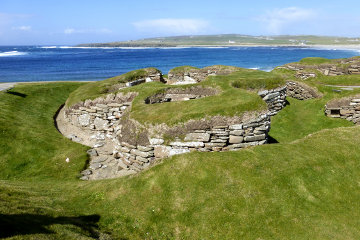
| |
| A view looking over part of the site of Skara Brae, with the Neolithic houses in the foreground. |
One of the sights we particularly wished to see on the Orkneys was the ancient village of Skara Brae. A storm in the winter of 1850 swept away part of a large sandy mound and uncovered the remains of some curious houses. The local laird, who lived in Skaill House two hundred yards away, investigated and carried out some minor repairs - one of the ancient houses has a wall with a window, put in at the insistance of Mr Watt's daughter, who used the building as her play house!
The site was finally investigated properly in 1927 by Professor Gordon Childe, an Australian who worked most of his life in Britain, in part because his far-left views did not find favour in his home country! (The unfortunate man feared old age and ended his life by jumping off a 1,000' cliff in the Blue Mountains, not far from where he grew up.)
His excavations - and further investigations since - uncovered a remarkable village. The houses consisted of a large central room, off which several low and much smaller chambers opened. There was, however, one chamber in each house that was higher and it is now believed, on the basis of the drains that ran beneath them, that it was an indoor toilet! The walls were a double-wall of dry-stone walling, in between which was a thick mass of "midden" - basically the rubbish that had accumulated around the village over a considerable preceding period.
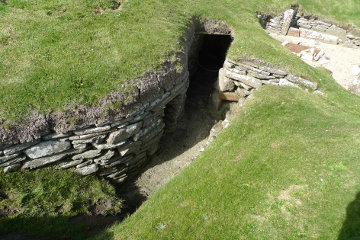
| |
| The covered passage between two houses, with the entrance to one house on the left. |
The walls, which were up to 6' thick, provided shelter from the wind and a degree of insulation against the cold. Further protection was offered by the narrow and low entrance passageways into the houses, which were only 3' high and less than 3' in width and which could be closed by a wooden or stone door held in place by a bar. In the final stages, even the space between the houses was covered over and formed a network of tunnels by which one gained access to the houses. Whether this was a deliberate defence against attackers or the cold or merely a pragmatic response to the increasing piles of "midden" we cannot tell.
What was surprising to Professor Childes and to others who regarded the Neolithic people as only slightly developed ape-men was the discovery of considerable sophistication in the village. As well as the interior toilets, each house had a stone "dresser" facing the entrance. It is possible that this structure had a ritual significance but modern opinion prefers to regard it as a place where the family could display its prize possessions - souvenirs from Sunny Brighton, perhaps, family photographs or attractive pots of flowers or jewellery.
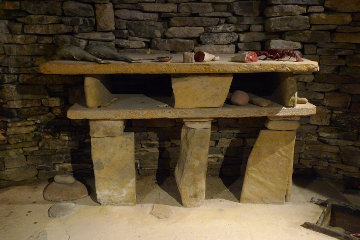
| |
| House 7 has been reconstructed so that visitors can wander around it. This is the "dresser" in that house. |
On either side of the room were boxes constructed of thin stone slabs. The size of these boxes makes it clear that they were, in fact, beds and the box was doubtless filled with heather, covered with furs and with further furs as blankets. In addition, in the outer corners of the box there were taller stones which have been interpreted as fastenings for curtains whose upper end were attached to the walls. These curtains could be drawn to provide privacy and extra warmth, in very much the same way as the beds in the "Black Houses" we saw on the Hebrides, which were inhabited into the 1960s.
Curiously, as you enter the house, the bed on the right is always larger than the bed on the left, and their comparative dimensions have led to the suggestion that one was for the husband and the other for his wife. I fear that idea ignores the fact that where you have a husband and a wife you will have children, and as there were only two beds in each house it is more likely that the shorter bed was for the children and the longer one for the parents. Beads and cosmetic paint pots found in the smaller beds again point to careless girl children rather than a wife and mother who knew the value of such things and could be relied upon to conduct a thorough search for the beads of a broken necklace.
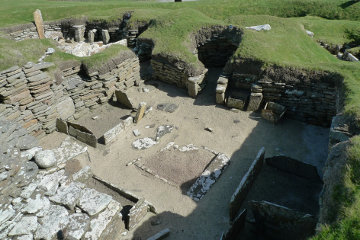
| |
| Two stone beds can be seen in this picture, which is looking from the entrance towards the ruined "dresser". |
Naturally it was assumed that the primitive inhabitants of Skara Brae were hunter gatherers or, at best, pastoralists who lived off their flocks and herds. The application of modern techniques to the midden revealed the presence of seed grains in the earliest levels, implying that the Neolithic people farmed barley and may well have grown other crops - though agriculture was limited, not by the intelligence or civilisation of the people but by the harsh northern climate with its short, cool summers and salt-laden winds.
Professor Childe dated the village to 500 BC, partly because it was unthinkable that its sophisticated features could come from any earlier period. Radio-carbon dates established in 1972 put the first occupation of the village to 3180 BC, making it older than the pyramids of Egypt. Occupation continued for six centuries, ending around 2500 BC.
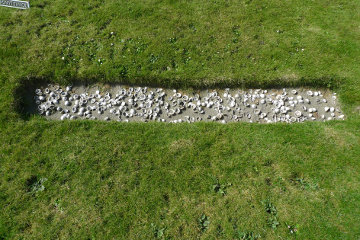
| |
| A strip of turf has been removed to reveal the shells which make up the midden around Skara Brae. |
However it is clear that the site was occupied much earlier than 3180 BC, because the houses were cut into a huge mound of "midden", a technical term used to describe mounds of waste from human activity. This can consist of shells, animal bones, human extreta and animal dung, in fact, anything which is no longer wanted by the people gets thrown out and gradually forms a mound. Even in our age of plastic packaging and throw-away furniture, it would take some time to create a mound of rubbish the size of the Skara Brae midden - and it must have taken the Neolithics several centuries at least, if not a millennium or two.
There is just one problem: it may be excellent theory, but does it work in practice?
Let's consider a few of the difficulties with this traditional story. If there were a millennium of hunter-gatherers who built up this midden, they must have been very hardy folk to cope with the Orkneys' weather without shelters! Even in these days of global warming my wife and I frequently felt as if our legs were being cut off at the ankles by high-power blasts of freezing air when the wind was from the north!
In addition, they were extraordinarily tidy folk. Although they doubtless ranged the length of the beach searching for whelks, winkles and whatever else was edible - having eaten them, they went to all the trouble to bring the shells back to the southern end of the bay and add them to the growing mound of midden instead of discarding them wherever they happened to be.
But if these hunter-gatherers were slightly incredible, so were the builders of Skara Brae, who dug into this enormous mound in order to bury their houses. Some of the walls still stand 6' high, but you try digging into a loose conglomeration of shells and bones and see how vertical the resulting cut is! The only way they could have done it without causing a landslide of midden material would be to build the dry stone walls from the top down as they dug - their stone-laying skills must have been truly phenomenal!
However the interior wall of the house has now been built and between you and your neighbour there is a solid mass of midden, providing the all-important insulation against cold weather and a guarantee that your dry-stone wall is windproof. But that was not enough for our Neolithic friends. They must dig out the area between the houses so that they can construct an outer wall approximately 5' away from the inner wall (once again constructing the wall from the top down in order to prevent landslides).
Does all this seem ever so slightly unlikely to you? Isn't it far more likely that the house walls - both inner and outer - were built on open ground and then the space between them filled with midden material brought from elsewhere?
Of course, that does imply a pre-existing midden, but in view of the consideration above, this midden was not built up by wide-ranging hunter-gatherers, but by a previous settlement on the site. There is plenty of room for such a settlement; not only has Skara Brae been cleared rather than excavated, so that we do not know what lies beneath the floors and walls of the houses, but much if not most of the site has been washed away by the sea, so the earlier settlement may well have been where the modern beach now lies.
So if the usual story about Skara Brae has serious difficulties, what confidence can we put in the dating?
There is a significant difference between facts and interpretation. The fact is that the houses of Skara Brae are surrounded by midden, the interpretation is that they were cut into the midden, an interpretation I believe to be mistaken. The fact is that radio-carbon indicates a date of 3180 BC (no doubt plus or minus the usual margins of error). Is there any interpretation in this?
I believe that there is. The science of radioactivity is still only a century old and when you are talking about processes that take thousands of years (like the half-life of C-14) it is difficult to be absolutely confident in the assertions of the scientists. In particular, it is difficult to be absolutely certain about the claim that radio-active decay cannot be speeded up or slowed down. The media recently (May 2016) reported the possible discovery of a fifth force in nature in addition to the four currently recognised (gravity, electromagnetism and the weak and strong forces between atoms). At present it appears that radio-active decay cannot be changed, but future discoveries may alter that.
What is more variable is the ratio of C-14 to C-12 and as that is what is measured when scientists do carbon-dating, there is considerable room for uncertainty about how that ratio should be translated into actual years. If, for example, there was some local techtonic activity that emitted carbon dioxide, plants and animals in the area would have a higher ratio of C-12 to C-14 and thus appear to be older than they really are.
Nevertheless, all that is speculation. It seems sensible to accept that according to our present knowledge the Neolithic people of Skara Brae established their settlement around 3180 BC and that there had been a couple of centuries of human activity on the site before that.
That is a problem for those who place Noah's Flood around 2,600 BC. I'm afraid that I cannot accept that date. I have no doubt that the Bible's history of the patriarchs is accurate but I do not believe that it is complete. We know that some versions of the Genesis text include an extra Cainan among the post-Flood patriarchs and there may well be other names missed out. I am as sceptical of those who claim to tell you the exact time and date of Creation as I am of the scientists who confidently assert that the world is billions of years old.
To my mind the best solution to the problem is to adopt a sort of Schrödinger's Cat mentality and think of human history in the world as both 6,000 years old and tens of thousands of years old. Until you look in the box you can't tell whether the infamous cat is alive or dead; until further information comes in we cannot tell the exact age of humanity.
© Kendall K. Down 2016





